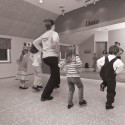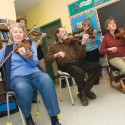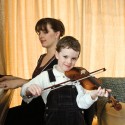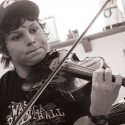Fine Fiddling and Flying Footwork
Step Dancing In Headwaters Has Two Local Heroes
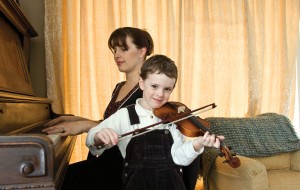
Step dancer Chanda Gibson accompanies her four-year-old son Xavier. “The rhythm and music is in their blood,” says Chanda of her three children. Photo by Pete Paterson.
Who can resist the finger-snapping, foot-tapping appeal of a down-home fiddler, especially when paired with a step dancer’s flying footwork? Certainly not four-year-old Chanda Gibson.
“It was the sound of the taps that immediately appealed to me,” says Chanda, now 33, recalling the moment she saw stepper Buster Brown teaching a class in her Ottawa Valley hometown of Cobden, Ontario in 1978. “I was immediately hooked.”
Buster Brown (later inducted into the Ottawa Valley Country Music Hall of Fame along with his wife, Pauline) learned his first steps from Donnie Gilchrist – the man credited with blending the old-country traditional step dance varieties he had witnessed growing up in the Ottawa Valley lumber camps to create the Ottawa Valley Step Dance style.
“Buster taught me for four years and also taught Debbie Reid, who was later my teacher for four years, so I learned the style right from the source,” says Chanda. By the time she was twelve, Chanda was ready to create her own routines and individuality, something encouraged in step dancing. And by age fourteen, she had begun teaching, a love that continues today.
With a performance record that includes an impressive string of awards, including two Canadian championships, Chanda has now settled her family and career in Orangeville. She was lured here by Bill Elliott, who founded the Orangeville Fiddle and Step Dance Camp in 1993 and who Chanda says is “largely responsible for keeping fiddling and step dancing alive in this area.” Bill had seen Chanda compete and asked her to teach at the summer camp while she was attending the University of Waterloo.
In 1995, after two successful years as a camp instructor, Chanda found her young step dancers were eager to continue training throughout the year. Realizing the potential for the growing step dance community, Bill asked if she would commute to Orangeville to teach on Saturdays. Starting with a dozen or so students, Chanda taught wherever space was available – at the Legion, the curling club, and in the United Church basement.
Bill, who moved to Orangeville in 1974, is a native of Bobcaygeon and came by his love of fiddling and step dancing naturally. “My dad was one of the original organizers of the Bobcaygeon fiddle contest,” he says. Of Irish/Scottish descent, Bill grew up watching Don Messer’s Jubilee, CBC television’s hugely popular fiddle and dance program of the 1960s.
Although he neither plays fiddle nor dances, Bill says, “I’ve been going to fiddle and step dancing events for almost forty years. I just love the music.”

Bill Elliott: “We take absolute beginners …by the end of the week they’re playing a tune.” Photo by Pete Paterson.
As a regular at contests throughout southern Ontario, Bill got to know the competitors personally, and it was their desire to have a place where they could improve their techniques and learn new steps that prompted him to establish the Orangeville camp.
“The first year we had about thirty students, the next year seventy and then one hundred and ten, so we have had to cap it at one hundred,” Bill says. The camp regularly reaches capacity, drawing students from throughout North America – Alaska, California, Tennessee, Vancouver – as well as England.
Last year a woman and her ten-year-old twin daughters came from Pangnirtung, Baffin Island, mom to fiddle and twins to step dance. The camp accepts ages eight and up – with an 87-year-old man as the oldest to have enrolled. Even ballet teachers and classical violin teachers have attended to learn step dancing and fiddling “because their students are demanding it.”
Held on the grounds of Upper Canada Camp in Adjala Township, the camp will celebrate its fifteenth season this year from July 13 to 18.
“We take absolute beginners who have never held a fiddle,” Bill says. “By the end of the week they’re playing a tune.” An optional class at the end of the day allows fiddlers to try step dancing or take special workshops in backup fiddle, square dance or gospel fiddle. Each camp concludes with a student concert.
Camp teachers from across the province are hand-picked for their talents. “The fiddle and step dance community is like a family,” Bill says. And Bill is the local patriarch, a role honoured in the Bill Elliott Jig, composed by Webb Acheson, an old-time fiddler and former camp teacher.
Kendra Norris and Scott Woods, brother and sister from Fergus and recipients of numerous awards including championships at the Shelburne Fiddle Contest, have taught at the camp on and off since its inception. It speaks to the camp’s quality that both teachers and students return year after year. Some students will change course from fiddle to step dance or the reverse, and some who began as students have graduated to teachers.
But camp time is not all hard work. Bill’s friends, Lynn and Tom Smith, are camp directors. Experienced with Scout and Guide camps, the Smiths make the best of the campers’ recreational time.
“The chocolate pudding slide is one of the favourites,” Bill says, chuckling as he describes a wading pool of pudding and the slide that ends in the pond. “After four and a half hours of instruction we believe the students need time to unwind and relax from the tension of classes.”
A member of the Orangeville Rotary Club, Bill has helped out the Shelburne club with their acclaimed Canadian Open Old Time Fiddle Championship for several years. “This is an amazing event,” Bill enthuses. “I don’t think there’s a Rotary Club anywhere in the world that has had an event going for fifty-eight years.”
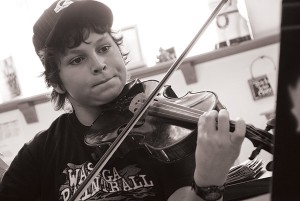
Sam Nassey brushes up on his fiddle techniques at a recent weekend workshop held by Bill Elliott at The Maples near Orangeville. Photo by Tom Partlett.
Bill also finds time to run an extensive Canadian fiddle website and to organize two weekend fiddle workshops annually – in February and October – easily reaching his capacity of thirty students. All this besides running his own business, Broadway Engraving.
In 1998 Bill was the recipient of the Porcupine Jack Hayes Award. Created by University of Toronto campus radio station announcer, Steve Fruitman, the award is “to commemorate the preservation of old-time music and country dance.” Fruitman noted that “Bill thinks so much of the tradition that he decided not to pollute it by taking up the fiddle himself.” Indeed, Bill admits that Kendra Norris’s efforts to teach him the fiddle “were hopeless” and learning step dance from Chanda was “even funnier.” But, he adds, “I’m the number-one fan.”
And he knows talent when he sees it. “Chanda is the best step dancer in Canada,” Bill says sincerely, knowing he’ll miss her talent this year when she takes a break from the camp to focus on her young family. Chanda’s student, Sarah Robinson, 19, will step into Chanda’s teaching shoes this year. Sarah has been making a name for herself over the past few years, winning high honours in area competitions, and she is an example of a dancer who began as a camper and now returns to share her skills.
On the date of my interview with Chanda we are often interrupted by the mewing cries of her newest arrival, two-week-old Mariah, a sister for four-year-old Xavier, and two-year-old Aliyah. Life has changed dramatically since Chanda graduated from the University of Waterloo with a degree in recreation and leisure a decade ago and she reminisces about the early, heady days of her career.
“I auditioned for Needfire in 1998, just before I graduated, and it was an awesome experience,” Chanda recalls. She choreographed her own feature parts in the short-run Princess of Wales Theatre production that celebrated Canadian Celtic heritage. Unfortunately the stress of continued aggressive dancing ended in injury. She fractured a tiny sesamoid bone in her right foot and continues to suffer from sesamoiditis (similar to tendonitis).
“I should probably not have continued to perform, but I was young and eager and I did,” Chanda says.
When Needfire returned for a second Toronto run in 2000, Chanda acted as a choreographer and auditioned other step dancers. Then, despite the foot injury and a bout of ill health, Chanda went to Scotland that same year to perform in Rhythms of the Celts.
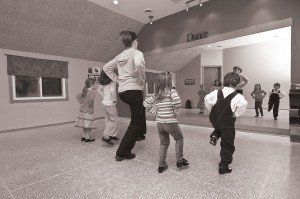
Young students refine their moves in Chanda Gibson’s spacious studio in Orangeville. Photo by Pete Paterson.
In 2002 Chanda purchased a house in Orangeville, its attached garage perfect for renovating into a small studio for her ever-increasing enrolment. Later that year she married long-time sweetheart Frank Leahy, a member of his family’s eponymous Celtic band, Leahy.
Frank, his three brothers and four sisters, are highly experienced on the international circuit, performing with the likes of acclaimed fiddler and step dancer Natalie MacMaster (married to Leahy brother, Donnell) and touring with Shania Twain. Frank is the drummer for his fiddling, singing, step dancing siblings. Chanda has toured and performed with the group (once while pregnant with her first child) and she is featured on the 2006 PBS special Leahy Live from Gatineau, Quebec.
Chanda’s studio currently has an enrolment of about 100 students. They come from as far away as Bancroft, Oshawa and Dundalk and range from beginners to seasoned competitors and family show groups. “Right now I depend on my four teachers a lot,” she acknowledges. Especially these days, as she manages the family alone while Frank is away on a two-month American tour with Leahy.
Still, despite the constraints on her time, she says she is more creative under pressure, coming up with innovative ideas and choreography she might not have otherwise channelled.
As for the future, Chanda’s dream is for her and Frank to have their own performing family, similar to Leahy and other Celtic performing families.
“The rhythm and music is in their blood,” Chanda says of her children. “Xavier is already fiddling and taking step dance lessons. The girls will do likewise, and then we’ll see what happens.”
Step Dancing in Canada
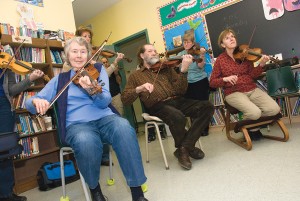
Sue Meggs, Peter Cole, Barb Terrett and Nancy Urekar (above, foreground) and Sam Nassey (left) brush up on their fiddle techniques at a recent weekend workshop held by Bill Elliott at The Maples near Orangeville. Photo by Tom Partlett.
From the late eighteenth through the nineteenth century, waves of Celtic people immigrated to Canada from their homelands of Scotland, Ireland, France and England. They shared a common language, Gaelic, and brought with them a strong cultural history. A vital part of their culture was the leisure activity of step dancing, accompanied by fiddle, bagpipes, accordion or mouth organ.
Despite centuries of repression in their homelands, step dancing remained alive (sometimes covertly, due to religious controversy) as a form of entertainment and celebration at weddings and other social gatherings.
In Canada, Celtic immigrants mostly settled in the Atlantic provinces, western Quebec and eastern Ontario, though the Headwaters area, too, became home to so many British immigrants that surveyors named Albion, Caledon and Erin townships to suggest England, Scotland and Ireland. In each region, step dancing evolved distinctively, passing down through generations to create several unique Canadian styles.
Internationally, the blockbuster productions of Lord of the Dance and Riverdance brought the visual excitement of step dancing to the main stage and made a superstar of Irish-American dancer and producer Michael Flatley.
The last few decades have also witnessed a strong resurgence in Canadian step dancing, due in part to the popularity of such traditional musical groups as the Rankin Family and the Celtic-rock fusion of such artists as Ashley McIsaac and Natalie MacMaster. In 1998, the successful Canadian production of Needfire celebrated the music, dance and song of Scottish and Irish immigrants and their evolution into a truly Canadian art form.
The Ottawa Valley Step Dance style
The Ottawa Valley Step Dance style has its roots with the immigrant lumberjacks who moved logs along the Ottawa River. They burned off the toil of the day with their energetic recreational step dancing, a distinctive combination of homeland styles and aboriginal influences. Beginning in the late 1960s, American tap dancing and clogging, as well as the introduction of group dancing further shaped the Ottawa Valley style.
Fast paced, rugged and energetic, the Ottawa Valley Step Dance style features high-flying legs and steps, demanding co-ordination and flexibility. Unlike other styles that are performed in shoes with hard leather soles, the Ottawa Valley style uses character or jazz shoes with metal taps or “clickers” attached to the toe and heel in order for the dancer to emphasize the rhythm of the music and create a “jingle” sound.
The torso is more relaxed than other rigid upper body forms of step dancing and there is greater use of the arms to complement the dancer’s movements. Although the style follows certain guidelines, dancers are encouraged to inject their individual personality and style. Reminiscent of the day when dances were performed in the confined space of a pioneer kitchen, on a tabletop or on an old door, today’s dancers perform on hardwood boards, Masonite boards, sanded Plexiglas or puck board (polyethylene sheathing). Traditional fiddle music is still required to accompany the clog, jig and reel in competitions, but current Celtic music and Celtic-rock fusion is flavouring today’s style.
Information on the Orangeville Fiddle and Step Dance Camp, links to area teachers and information on Canadian fiddling: www.fiddle.on.ca
The Canadian Open Old Time Fiddle Championship takes place in Shelburne

